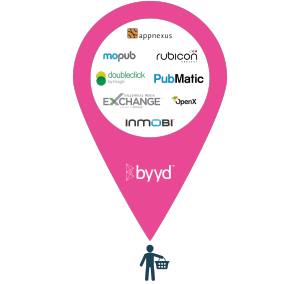Geolocation is the essence of mobile. When consumers pop their mobiles in their pockets, they carry your advertising, so if you know where they are, you can make advertising more relevant and effective. This is just one reason why location-targeted mobile ad revenues are predicted to skyrocket, according to analysts such as BIA/Kelsey.
However, the world’s a big place. To make location targeting really work, you must plug in as much data and inventory as possible. Otherwise, you won’t have enough of either to make it worth an advertiser’s time or money. It’s an apparent paradox, but it’s true: you have to be big to go small.
Geotargeting by Points of Interest
Targeting by location has been around for quite some time in mobile. Take a latitude and longitude, draw a radius around that point, and then target devices within it by either matching their IP address to data, or getting it direct from the GPS in the device through the app or site they’re browsing.
Geo-targeted campaigns reach high-interest audiences. They reduce waste, by ensuring that more impressions are being delivered to the right users. And, by delivering more relevant campaigns, they increase return on investment for clients.
But, sophisticated as it may be, geotargeting is only the beginning. While it’s good at targeting people within a location, it doesn’t take into account places they’ve visited, such as supermarkets or sports venues. This is called Point of Interest targeting and it’s where advertising can pinpoint devices with great accuracy.
 One POI technique is called geoconquesting. This involves targeting competitor stores, and it’s been around since well before the digital age: if you’ve ever been about to visit McDonalds and been handed a promotional leaflet for Burger King, you’ve seen geoconquesting at work. And certainly, voters in the UK general election will know what it’s like to be canvassed intensely by hopeful politicians vying to oust the incumbent.
One POI technique is called geoconquesting. This involves targeting competitor stores, and it’s been around since well before the digital age: if you’ve ever been about to visit McDonalds and been handed a promotional leaflet for Burger King, you’ve seen geoconquesting at work. And certainly, voters in the UK general election will know what it’s like to be canvassed intensely by hopeful politicians vying to oust the incumbent.
It’s by capturing audiences at the point of decision that geoconquesting works. And it does work, delivering in some cases up to 30% higher clickthrough rates.
However, location targeting of whatever flavour only operates in the here (and there) and now. It’s when you start looking at where people have been, and inferring patterns about their behaviour and where they might go to in future, that you take targeting to the next level. We call this geotargeting by proxy.
Geotargeting by proxy
By observing over time where devices are, we can start to understand the relationships between users and the places they visit. We can infer their interests and visitation habits. We can then tailor advertising to match their behaviour.
Take the example of two audiences: tradespeople and DIYers. The tradesperson goes to the local trade supplier, while the DIYer heads to the home improvement store. We pick up on this because we have the data identifying the stores, and can then use algorithms to determine whether this is a significant pattern.
If so, we can target their devices with relevant ads when they’re not even at the store, for example when they’re at home or simply out and about. We know they should be interested in home improvement in future, because they visited home improvement stores in the past.
This has created a dynamic sector from a seemingly disparate audience. By identifying where devices have been, and through using some smarts, you can understand a person’s interests and direct ads to that user.
It is clever because it is big
It should be apparent by now that, to make POI targeting work, whether through geoconquesting or geotargeting by proxy, you need the data and inventory. You need scale.
Firstly, there is scale of data. You need to know that you have a large data source to know about enough people given any point of interest. It’s no use promising to a client that you can reach an appreciable number of people at, say, local supermarkets when the data is lacking and the campaign doesn’t deliver in full to the maximum potential audience.
If you look at the graphic accompanying this piece, which is based on real data, you’ll see how points of interest can vary. Some sectors such as sports venues have few POIs, but huge audience device figures – that is, not a vast number of football stadia for example, but huge attendance figures at matches. Others such as auto have many more POIs (auto stores dotted around the area) but have smaller device figures (people buying and selling cars).
When you have this level of data, you can show clients exactly who and how many people their money is going to reach, and this will differ depending on which sector they want to reach. This is as transparent as it gets.
Secondly, there is scale of inventory. So you’ve got the lat/long and the POI data and device ID (in the case of geo-proxy). What about actually having access to the inventory within those areas? Unless you’re plugged into as many sources of inventory, across exchanges and through direct agreements, you will simply not be party to these opportunities.
So if geolocation forms the basis of making mobile work, then it’s by superimposing big data, huge reach and smart algorithms that you make it work harder. The data and reach are necessary to get big enough so that you can go small, while the algorithms ensure that, when ad requests come through, you win on behalf of your client.





